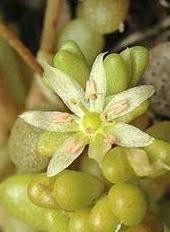Pigmy purslane
(Calandrinia pygmaea)

Description
Calandrinia granulifera is an annual herb in the family Montiaceae, and is native to New South Wales, Tasmania, Western Australia, South Australia, and Victoria. It is a succulent, erect to decumbent herb, flowering from September to November with white-pink flowers. It grows on sandy and gravelly soils on granite outcrops and slopes. The flowers are on pedicels (stems) which are 0.5–2 mm long and erect when in fruit. The bracts are alternate. The sepals are deciduous and 1.5–3 mm long. There are 5-7 petals, 5-10 stamens and 3 stigmas. The black capsule is almost spherical with three short valves which open at the apex only. The numerous, red-brown, shiny seeds are about 0.5 mm long and 0.4 mm wide. For an illustration of the colliculate seeds, see PlantNet Calandrinia granulifera was first described by George Bentham in 1863. Calandrinia are a large genus of flowering plants known as purslanes and redmaids. It includes over 100 species of annual and perennial herbs which bear colorful flowers in shades of red to purple and white. Plants of this genus are native to Australia, western South America, Central America, and western North America. Some species have been introduced to parts of New Zealand, southern Africa, Asia, and Europe. Species in the genus Calandrinia are annual or perennial herbaceous plants with a sprawling or erect habit. The leaves are mostly basal and may be either alternate or opposite in arrangement. Flowers are produced in cymes. Each flower produces between four and eleven petals, though often five. Flowers may be white, purple, pink, red, or yellow. The genus Calandrinia was erected in 1823 by German botanist Carl Sigismund Kunth. It was named for Jean Louis Calandrini (1703–1758), a Genevan botanist. The genus is classified in the family Montiaceae. It was previously placed in the purslane family, Portulacaceae.
Taxonomic tree:







